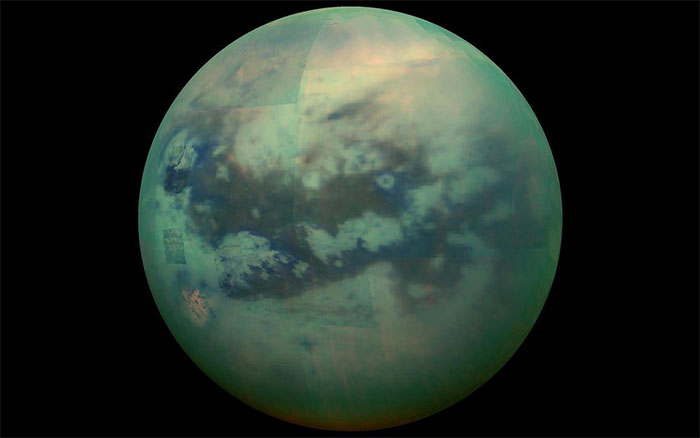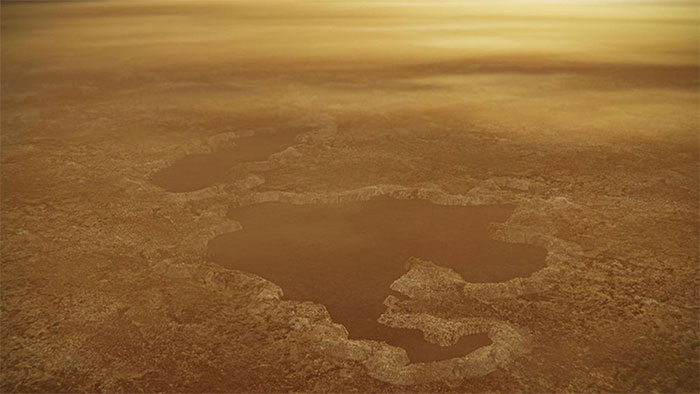Surprisingly, Titan, Saturn’s moon, contains more flammable gases than Earth. However, what would happen if they accidentally ignited?
The gas in question is methane. Why is methane found in such abundance on Saturn’s moon Titan?
Titan is Saturn’s largest moon, larger than Mercury, with a mass comparable to that of Pluto. The most remarkable feature of Titan is its thick atmosphere.
Studies indicate that Titan’s atmosphere consists of up to 98.44% nitrogen. This means that Titan is the only nitrogen-rich body in the Solar System, aside from Earth.

Titan, Saturn’s moon, holds many mysteries yet to be unraveled. (Image: NASA)
In addition to nitrogen, Titan’s atmosphere contains many hydrocarbons, including methane (CH4), ethane (C2H6), and carbon dioxide (CO2). However, scientists speculate that there is a significant amount of methane and ethane on Titan.
Moreover, scientists have discovered that Titan’s temperature is extremely low, around -180 degrees Celsius. If there is a lot of methane on Titan, it would not exist in gaseous form; instead, it would transition to a liquid state at temperatures around -160 degrees Celsius.
From this reasoning, scientists hypothesize that there are numerous methane lakes on Titan. Experts have also noted many bright spots when observed through telescopes, which could potentially be reflections from lakes or liquid oceans. One notable example is Kraken Mare, which accounts for 80% of the liquid on Titan’s surface.
According to astronomer Valerio Poggiali at Cornell University’s Center for Astrophysics and Planetary Science, if placed on Earth, this body of water would cover an area equivalent to five of North America’s largest lakes.
Enormous Methane Lakes on Titan Have Surprising Depths
On September 15, 2017, the Cassini spacecraft plunged into Titan’s atmosphere to “self-destruct,” concluding its 20-year mission exploring Saturn. However, the data transmitted back continues to yield surprising new discoveries. Although there are still many unknowns, the data from Cassini has provided us with new insights into Titan, Saturn’s moon.

The surface of Titan exhibits natural conditions similar to Earth. Image: NASA
According to a study published in the journal Planetary Geophysical Research in early 2021, the massive Kraken Mare lake is nearly ten times deeper than previously estimated.
Earlier, based on data collected by the Cassini spacecraft, astronomers determined that Kraken Mare was over 300 meters deep. However, the reality is that the lake is so deep that Cassini’s radar could not reach the bottom.
Notably, the composition of this lake has also surprised scientists, as it contains a mixture of methane and ethane. Scientists hope to soon uncover the source of the liquid methane on Titan, thereby shedding light on some of Titan’s mysteries.
According to scientists’ hypotheses, Titan contains large quantities of methane and other gases. In other words, Titan is a massive natural gas reservoir, and the natural gas content of this moon could be hundreds of times greater than that of Earth. Therefore, if humanity can effectively harness these gas resources, it could significantly contribute to future development.
However, methane is a highly flammable gas. Thus, Titan could also be seen as a “bomb” that is very easy to explode. So, what would happen if one day the enormous gas reserves on Titan were to ignite?
What if Titan Caught Fire?
According to scientists, the likelihood of Titan catching fire is very low. Data and previous analyses suggest that Titan’s primary component is nitrogen, along with some other hydrocarbons. However, due to the absence of oxygen, combustion cannot occur, even with the presence of significant methane.
Even if external forces were to intervene and release a large amount of oxygen on Titan, it would not warm the moon, as Titan’s temperature is too low (-180 degrees Celsius).
Therefore, the vast natural gas reserves on Titan would not be lost. Additionally, there are liquids flowing on Titan’s surface, but this fluid is not water like the rivers on Earth; instead, it is a mixture of various hydrocarbons.

Titan contains many natural gases, including methane. (Image: BGR)
Titan resembles early Earth in terms of physical processes but differs in composition. Notably, Titan lacks liquid water, only having frozen water. However, scientists believe that Titan could potentially harbor life. After all, Titan is the only moon with a thick atmosphere found in the Solar System. The presence of methane in this atmosphere is also considered a potential basis for the existence of life.
According to scientists, during the combustion process, the ice on Titan may melt, and the methane lakes would also convert into gas, entering the atmosphere. This means the atmosphere could become more suitable for life to exist.
Titan – A “Promised Land” for the Search for Life?
Titan has natural conditions very similar to Earth, featuring clouds, rain, rivers, lakes, and even oceans beneath its surface. Titan’s atmosphere is four times thicker than Earth’s, primarily composed of nitrogen and methane. This has attracted the attention of astronomers.
As a result, NASA has consistently placed Titan, Saturn’s largest moon, at the top of its list of key targets for the search for extraterrestrial life.
According to Rosaly Lopes, a scientist and senior expert at NASA’s Jet Propulsion Laboratory (JPL): “We are trying to understand whether life could exist on Titan. Therefore, we want to know which compounds from the atmosphere reach the surface and whether they can penetrate the icy crust to reach the ocean below. Because we believe that the ocean is the most likely place for life to form.”
Being over ten times farther from the Sun than Earth, Titan receives about 100 times less solar energy than our blue planet. With this weak light, Titan should have converted methane in its atmosphere into ethane. However, current models suggest that somehow, this celestial body has cycled all the methane on its surface within just 10 million years.
Nasa experts are also studying the idea of a submarine and plan to launch this exploratory vehicle into Kraken Mare in 2030. Astronomer Valerio Poggiali at Cornell University’s Center for Astrophysics and Planetary Science stated that newly analyzed data from the Cassini spacecraft could help engineers better calibrate the sonar equipment on board.
With the high potential for life to exist on Titan, humanity is driven to conduct more detailed research on it. After all, the formation and evolution of life is the answer that scientists have long sought. Therefore, in the future, more exploratory missions will be sent to investigate this mysterious and fascinating moon.
Methane in the atmosphere is a potent greenhouse gas that can contribute to warming Earth. It is also a greenhouse gas with a much stronger heat-retaining capability than CO2. On Earth, methane originates from various sources, including decaying organic materials, livestock, and natural gas. In fact, simply mixing methane with other chemicals at 5% can cause explosions. Although not toxic, methane is a suffocating gas.
References: NASA, Space, Smithsonianmag, Odysseymagazine


















































